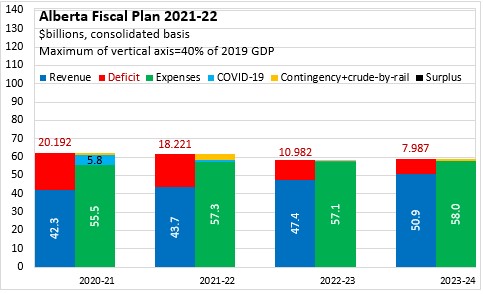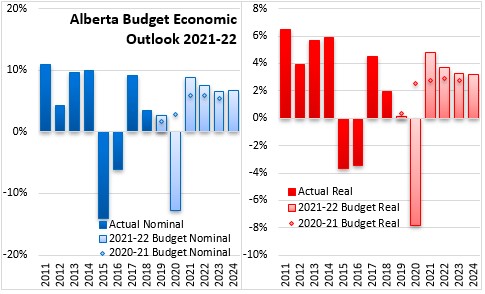The Economics and Statistics Division maintains archives of previous publications for accountability purposes, but makes no updates to keep these documents current with the latest data revisions from Statistics Canada. As a result, information in older documents may not be accurate. Please exercise caution when referring to older documents. For the latest information and historical data, please contact the individual listed to the right.
<--- Return to Archive
For additional information relating to this article, please contact:
February 26, 2021ALBERTA BUDGET 2021-22 The Province of Alberta released its 2021-22 Budget, featuring a deficit estimated at $18.221 billion, following a deficit of $20.192 billion forecast for 2020-21. Alberta's deficit is projected to decline to $10.982 billion in 2022-23 and again to $7.987 billion in 2023-24. Alberta's narrowing deficits are largely attributable to rising revenues in 2022-23 and 2023-24. Alberta's Budget continues to adjustments for crude-by-rail payments and contingencies into its expenditure outlook.
Alberta's Budget distinguishes COVID related expenditures from regular departmental expenditures and grants. In 2020-21, Alberta forecasts COVID spending of $5.8 billion (along with $55.5 billion in departmental spending). COVID spending is projected to decline to $1.1 billion in 2021-22 and then to $0.6 billion in 2022-23.

Alberta's fiscal plan has been significantly altered since the (pre-COVID) projections from the 2020-21 Budget estimates. Revenues for 2020-21 declined by almost $7.7 billion. Expenditures (before contingency, but including COVID spending) increased by $5.7 billion. Although expenditures are projected to fall while revenues rebound, Alberta's provincial government deficit is projected to persist to at least 2023-24.

Alberta's deficits are now projected to be substantially larger than expected in the 2020-21 (pre-COVID) fiscal plan.

Despite rising expenditures and falling nominal GDP, the footprint of the Alberta government (measured as a share of GDP) remains relatively low. Overall government spending, including COVID expenses and contingencies, amounted to 20.3% of GDP in 2020-21. This is projected to decline to 18.5% of GDP in 2021-22 and to 15.1% of GDP by 2023-24.
Alberta's forecast deficit for 2020-21 amounted to 6.6% of provincial GDP. The planned deficit narrows to 5.4% of GDP in 2021-22, 3.0% of GDP in 2022-23 and 2.1% of GDP in 2023-24.
Alberta's net debt-to-GDP ratio is projected to rise from 11.4% in 2019-20 to 20.3% in 2020-21 and to 24.5% in 2021-22. Alberta's net debt-to-GDP ratio is projected to rise to 26.6% by 2023-24. The Budget notes that the Province will keep the net debt to GDP ratio below 30%.

Alberta's economy faced a dual shock from both COVID and the decline in oil prices. Although there was a strong rebound in retail sales, housing construction and oil output after May 2020, limited business investment and employment gains have kept Alberta's unemployment rate elevated. Alberta's real GDP is estimated to have declined 7.8% in real terms (12.8% in nominal terms) in 2020. Growth prospects are strong with the roll-out of vaccines in 2021; real GDP is projected to rebound by 4.8% and nominal GDP by 8.8%. This rebound assumes that some public health measures remain in effect, limiting recovery in service industries and travel/tourism. Part of Alberta's economic rebound depends on higher oil production and investment activity as the Budget assumes benchmark oil prices (WTI in US dollars) recover to $46 in 2021 and to $55 in 2022. Consumer spending and housing activity are also expected to rise, but non-energy commercial investment is expected to remain weak. Beyond the pandemic, Alberta's economic growth is projected to average about 3.4% in real terms through 2024. As the global economy recovers from the COVID shock, Alberta's exports and business investment are expected to pick up.

Key Measures and Initiatives
The 2021-22 Alberta Budget prioritizes the health care system, particularly as vaccines are rolled out over the remainder of 2021. This includes placing on hold the results of a review of Alberta Health Services. To speed economic recovery, the Alberta Budget supports sector strategies to improve competitiveness and industrial diversification.
Alberta Budget 2021-22
<--- Return to Archive